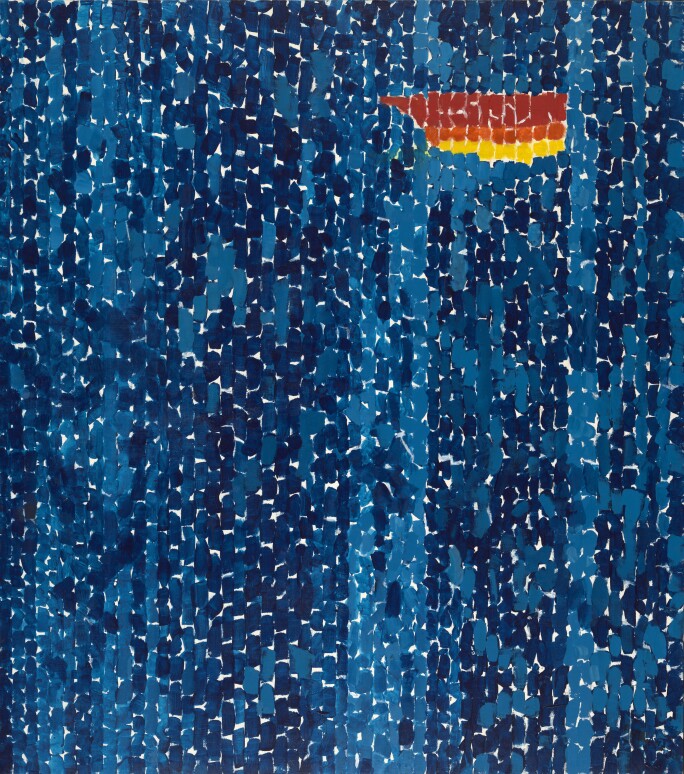“I’ve always felt deeply within myself that I was a damn good artist, though the world didn’t recognize me as such. I wasn’t about to play their game.”
Blossoming in vibrant colors undoubtedly reminiscent of lush flowers and foliage of the spring, Lynne Drexler’s Herbert’s Garden from 1960 is a vivacious exemplar of the artist’s facture and palette that have propelled the artist into acclaim in recent years. Marrying Post-Impressionist landscape painting with the distinct sensibility of Post-War painterly abstraction, the present work underscores Drexler’s iconic visual lexicon of short brushstrokes that dance across the canvas, seemingly extending beyond its edges, reaching into the natural world in a lush and lively composition. Atop a bed of canary yellow that invokes the gentle colors of spring wildflowers, brushstrokes of rosy pink, cobalt blue, rich teal, and lavish mauve, among others, flower into a veritable bouquet of color. Despite being overlooked for decades, Drexler’s paintings have now become some of the most celebrated and sought-after in the art world, housed in the renowned institutional collections of the Portland Museum of Art, the Farnsworth Art Museum, Rockland, the Provincetown Art Association and Museum, and the Mint Museum, Charlotte, among others.

Born in 1928 near Newport News, Virginia, Drexler began painting at a very young age, later pursuing a fine arts degree at the Richmond Professional Institute and the College of William and Mary. In 1956, Drexler decided to relocate to New York City to further her artistic practice, studying with Hans Hoffman in New York and Provincetown and with Robert Motherwell at Hunter College. Immersed in the New York downtown art scene—then charged with the transformative energies brought along by Abstract Expressionism—Drexler began crafting her iconic formal approach to abstraction, employing vivid colors and gestural, swatch-like shapes to animate and excite the canvas. The iconic patchworks Drexler produced in this early period of her career, like Herbert’s Garden, recall the spatial and chromatic frameworks of Hofmann while resonating with the facture of contemporaries like Jackson Pollock and Lee Krasner or even harkening back to the stylistic modalities of Gustav Klimt or Paul Signac.


The dynamism that emanates from the picture plane hints at Drexler’s inspiration not only in art historical titans of past but also her unique relationship with music, at the emotional center of her practice: “I would sit and draw through the opera… to the music. It was just the soaring… the gloriousness of the music. The beauty, the power and the glory of it.” (the artist quoted in: John Kenneth Alexander, Rick Miller, and Sue Miller, eds., Lynne Mapp Drexler: Her Way, Shelburne 2023, p.4) Drexler was a devoted follower of the Metropolitan Opera’s broadcast, even often attending the opera three times a week, drawing in her seat while the music played before returning to her studio and refining the abstract forms and shapes that expressed the feelings brought upon by the music. Drexler’s rhythmic brushstrokes, densely layered in metrically applied dabs of energetic hues, form a rich tapestry of synesthetic expression found across Drexler’s celebrated oeuvre.

Foregrounding the powerful sensibility drawn from the artist’s deep-seated appreciation for the natural world, music, and art, Herbert’s Garden is a symphonic painting of radiant beauty that epitomizes Drexler’s vision. Executed the year preceding the artist’s first solo show in 1961 at the prestigious Tanager Gallery, one of the first artist cooperative galleries whose illustrious members included Willem de Kooning and Alex Katz, the present work witnesses Drexler reach creative maturity and carve her singular artistic voice. Despite her extensive body of work, few had a sense of the depth of her practice, and it was not until the artist’s death in 1999 that the magnitude of her works was truly discovered; often overlooked by the New York establishment, Drexler is now undoubtedly a part of the generation of female artists reclaiming their deserved position in the Western artistic canon.




